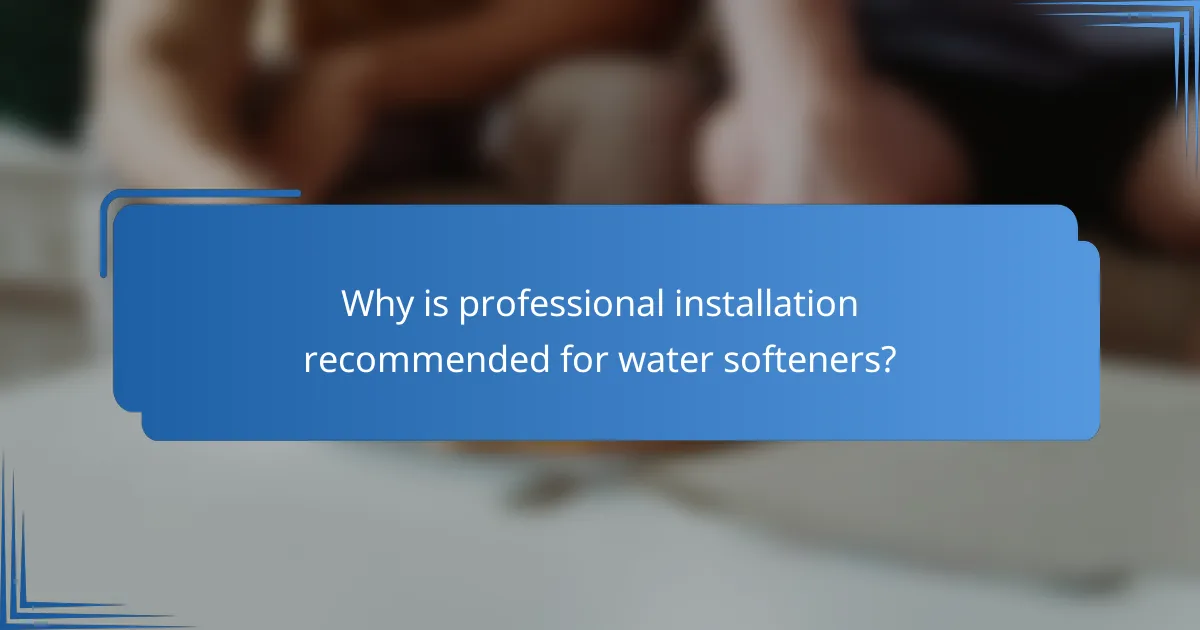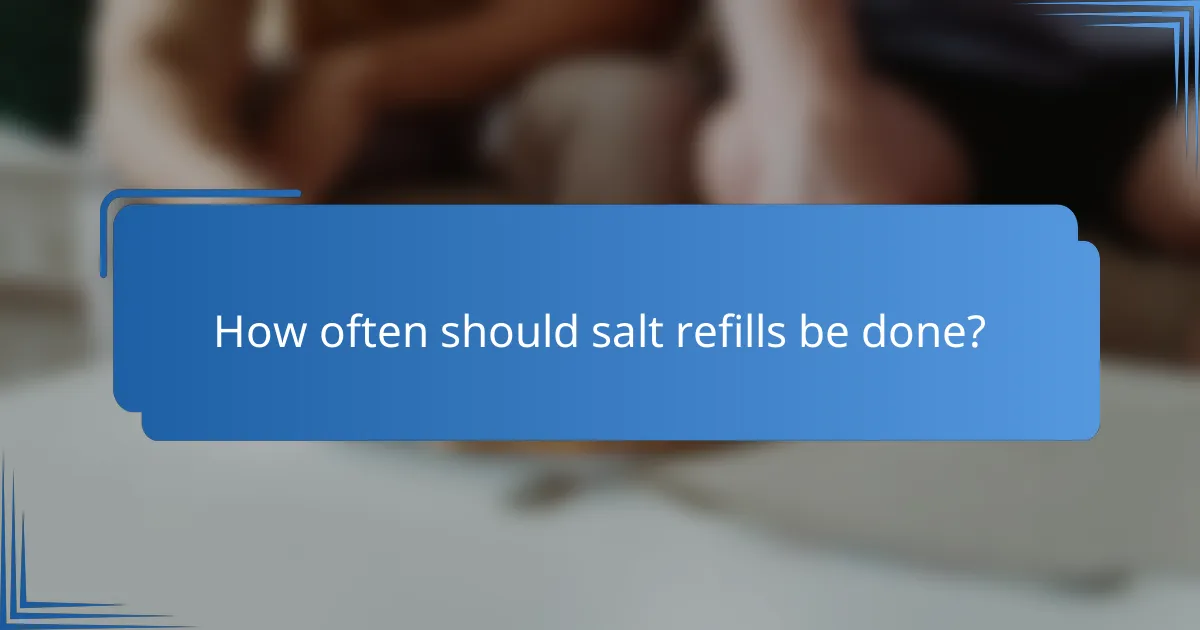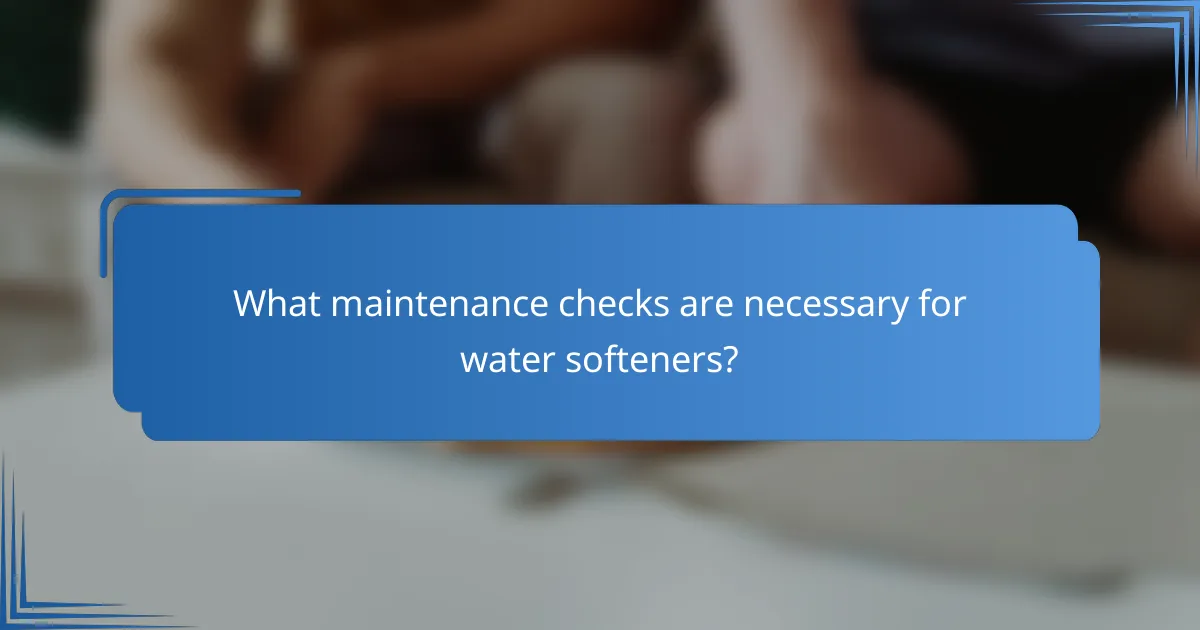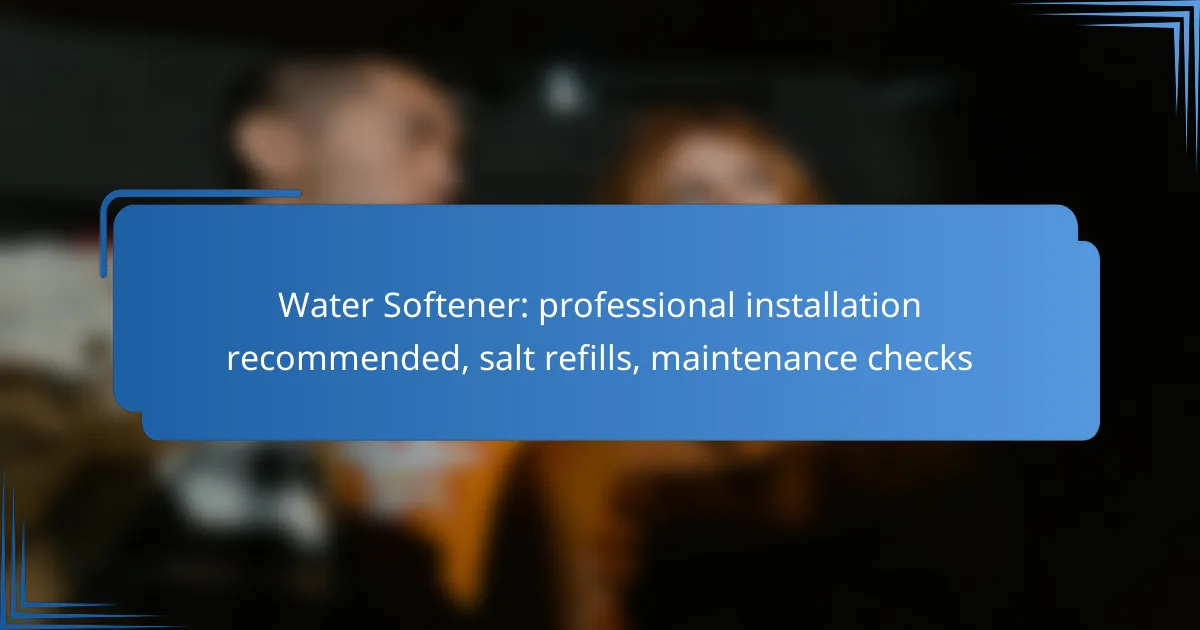Investing in a water softener is a smart choice for improving water quality, and professional installation is highly recommended to ensure it operates effectively. Regular salt refills every 4 to 6 weeks, along with routine maintenance checks, are crucial for optimal performance and longevity of the system. By adhering to these practices, you can enjoy the benefits of softened water while preventing potential issues related to hard water.

Why is professional installation recommended for water softeners?
Professional installation is recommended for water softeners to ensure proper setup and functionality. Experts have the necessary knowledge and experience to install the system correctly, which can prevent future issues and enhance performance.
Expertise in system setup
Water softeners require precise installation to function effectively. Professionals understand the specific requirements of different systems, including plumbing configurations and electrical connections. Their expertise minimizes the risk of errors that could lead to leaks or malfunctions.
Additionally, they can assess your home’s water quality and choose the most suitable system for your needs, ensuring optimal performance from the start.
Ensures optimal performance
Proper installation by a professional guarantees that the water softener operates at peak efficiency. They can calibrate the system to match your household’s water usage, which helps in achieving the desired hardness levels. This tailored setup can lead to significant improvements in water quality.
Regular maintenance checks by professionals can further enhance performance, ensuring that the system continues to function effectively over time.
Compliance with local regulations
Many regions have specific plumbing and installation codes that must be followed when setting up water softeners. Professionals are familiar with these regulations and can ensure that your installation complies with local laws, avoiding potential fines or issues during inspections.
Compliance is particularly important in areas with strict environmental regulations regarding water treatment systems.
Warranty protection
Most water softener manufacturers require professional installation to maintain warranty coverage. If a system is not installed by a certified technician, any future repairs or replacements may not be covered. This can lead to unexpected costs if issues arise.
By opting for professional installation, you safeguard your investment and ensure that you can take full advantage of the warranty benefits.
Time-saving
Installing a water softener can be a time-consuming process, especially for those unfamiliar with plumbing. Hiring a professional can save you valuable time and effort, allowing you to focus on other important tasks. They can complete the installation efficiently, often within a few hours.
Moreover, professionals can quickly troubleshoot any problems that arise during installation, further reducing downtime and ensuring that your system is up and running as soon as possible.

How often should salt refills be done?
Salt refills for water softeners should typically be done every 4 to 6 weeks, depending on usage and water hardness. Regular monitoring is essential to ensure optimal performance and prevent issues related to hard water.
Monthly refill recommendations
For most households, a monthly salt refill is advisable to maintain the efficiency of the water softener. If your system uses a significant amount of water, consider checking the salt levels every two to three weeks. Keeping an eye on the salt levels can help avoid running out, which could lead to hard water issues.
Factors affecting refill frequency
Several factors influence how often you need to refill salt in your water softener. These include the hardness of your water, the size of your household, and your daily water consumption. For example, larger families or homes with high water usage may require more frequent refills compared to smaller households.
Additionally, the type of water softener system you have can affect refill frequency. Some systems regenerate more often, which may necessitate more regular salt additions. Regular maintenance checks can help you understand your specific needs better.
Best salt types for water softeners
Choosing the right type of salt for your water softener is crucial for its performance. The most common options include solar salt, rock salt, and evaporated salt. Solar salt is often preferred for its purity and effectiveness, while rock salt is a more economical choice but may contain impurities that can affect your system.
Evaporated salt is the purest form and dissolves easily, making it ideal for systems that require minimal maintenance. When selecting salt, consider the specific requirements of your water softener and consult the manufacturer’s recommendations for the best results.

What maintenance checks are necessary for water softeners?
Regular maintenance checks for water softeners are essential to ensure optimal performance and longevity. These checks typically include inspections, cleaning, leak detection, and testing water hardness to maintain effective softening.
Regular inspections
Conducting regular inspections of your water softener is crucial for identifying potential issues early. Aim for inspections every six months to a year, checking for any signs of wear, damage, or malfunction.
During these inspections, ensure that all components, including the control valve and resin tank, are functioning correctly. Look for any unusual noises or irregularities in operation that may indicate a problem.
Cleaning the brine tank
Cleaning the brine tank is an important maintenance step that should be performed annually. Over time, salt residue and sediment can accumulate, which may affect the efficiency of the water softener.
To clean the brine tank, first, turn off the water softener and disconnect it from the power source. Remove any remaining salt, then scrub the tank with a mixture of water and vinegar to eliminate buildup before rinsing thoroughly.
Checking for leaks
Regularly checking for leaks is vital to prevent water waste and damage to your home. Inspect the area around the water softener and the plumbing connections for any signs of moisture or water pooling.
If you detect a leak, address it immediately by tightening connections or replacing faulty components. Ignoring leaks can lead to more significant issues and costly repairs.
Testing water hardness
Testing water hardness helps ensure that your water softener is functioning effectively. It is advisable to test the water hardness every few months, especially after significant changes in water usage or after maintenance work.
You can use a simple water hardness test kit available at home improvement stores. If hardness levels are higher than desired, it may indicate that the resin beads need to be replaced or that the system requires recalibration.

What are the costs associated with water softener installation?
The costs associated with water softener installation include initial installation fees, equipment costs, and ongoing maintenance expenses. Understanding these costs can help homeowners budget effectively and ensure they choose the right system for their needs.
Installation fees in major cities
Installation fees for water softeners can vary significantly depending on the city. In larger metropolitan areas, such as New York or Los Angeles, installation costs typically range from $500 to $1,500. Smaller cities may see lower fees, often between $300 and $800.
It’s essential to consider additional costs that may arise, such as plumbing modifications or permits, which can add to the overall installation price. Always request quotes from multiple professionals to find the best deal.
Average equipment costs
The average cost of water softener equipment can range from $400 to $2,500, depending on the type and capacity of the system. Basic ion-exchange systems are generally more affordable, while advanced options like reverse osmosis systems can be pricier.
When selecting equipment, consider factors such as the size of your household and water hardness levels. Investing in a higher-quality system may lead to better long-term performance and lower maintenance costs.
Long-term maintenance expenses
Long-term maintenance expenses for water softeners typically include salt refills and periodic maintenance checks. Homeowners should budget around $50 to $150 annually for salt, depending on usage and system size.
Regular maintenance checks, which may include inspecting the system and cleaning components, can cost between $100 and $200 every few years. Staying on top of maintenance can extend the lifespan of your water softener and ensure optimal performance.

How do water softeners compare to alternatives?
Water softeners primarily reduce hardness minerals like calcium and magnesium, while alternatives often address different water quality issues. Understanding these differences can help you choose the right system for your needs.
Water filters vs. water softeners
Water filters remove contaminants such as chlorine, sediment, and bacteria, improving taste and safety. In contrast, water softeners specifically target hardness minerals, which can lead to scale buildup in pipes and appliances.
When deciding between the two, consider your water quality concerns. If you have hard water, a softener may be necessary, while a filter may suffice for taste and safety issues.
Reverse osmosis systems
Reverse osmosis (RO) systems use a semi-permeable membrane to remove a wide range of impurities, including dissolved solids, heavy metals, and some microorganisms. Unlike water softeners, RO systems do not specifically address hardness but provide comprehensive purification.
RO systems are often used in conjunction with water softeners for optimal water quality. If your primary concern is both hardness and contaminants, combining these systems can yield the best results.
Cost-effectiveness of each option
Cost-effectiveness varies based on your specific water quality issues and household needs. Water softeners typically require an upfront investment and ongoing salt refills, while filters and RO systems may have lower initial costs but require regular cartridge replacements.
Consider the long-term costs, including maintenance and replacement parts. For households with significant hard water issues, investing in a water softener may save money on appliance repairs and energy bills over time.
